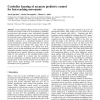Free Online Productivity Tools
i2Speak
i2Symbol
i2OCR
iTex2Img
iWeb2Print
iWeb2Shot
i2Type
iPdf2Split
iPdf2Merge
i2Bopomofo
i2Arabic
i2Style
i2Image
i2PDF
iLatex2Rtf
Sci2ools
BC
2000
2000
Cerebellar learning of accurate predictive control for fast-reaching movements
Long conduction delays in the nervous system prevent the accurate control of movements by feedback control alone. We present a new, biologically plausible cerebellar model to study how fast arm movements can be executed in spite of these delays. To provide a realistic test-bed of the cerebellar neural model, we embed the cerebellar network in a simulated biological motor system comprising a spinal cord model and a six-muscle two-dimensional arm model. We argue that if the trajectory errors are detected at the spinal cord level, memory traces in the cerebellum can solve the temporal mismatch problem between eerent motor commands and delayed error signals. Moreover, learning is made stable by the inclusion of the cerebello-nucleo-olivary loop in the model. It is shown that the cerebellar network implements a nonlinear predictive regulator by learning part of the inverse dynamics of the plant and spinal circuit. After learning, fast accurate reaching movements can be generated.
| Added | 17 Dec 2010 |
| Updated | 17 Dec 2010 |
| Type | Journal |
| Year | 2000 |
| Where | BC |
| Authors | Jacob Spoelstra, Nicolas Schweighofer, Michael A. Arbib |
Comments (0)

